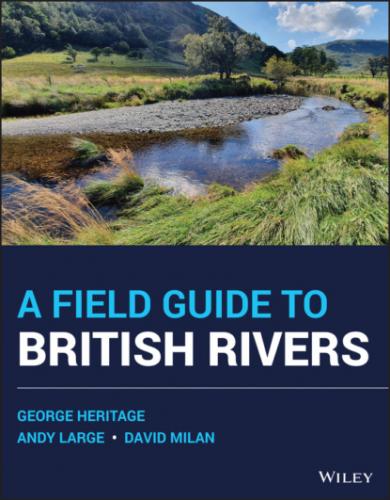A Field Guide to British Rivers. George Heritage
processes are assessed within a catchment context. The River Styles methodology reflects both river character and behaviour. As such the framework also provides a basis for assessing geomorphic river condition and recovery potential, framed in terms of evolutionary pathways for each channel type. The River Styles typology is summarised in Figure 2.3.
2.3.4 Extended River Typology
The Extended River Typology developed by Rinaldi et al. (2015) identified 22 morphological types (Figure 2.4) classified by confinement (confined, partly confined, and unconfined), dominant bed material calibre (bedrock, boulder, cobble, gravel, sand, and silt), and planform (straight‐sinuous, meandering, pseudo‐meandering, wandering, braided, island‐braided, and anabranching).
2.3.5 Scottish Environment Protection Agency (SEPA) Classification
As mentioned above, SEPA (2012) proposed a river classification system for Scottish rivers based on and developing the Montgomery and Buffington (1997) typology. Twelve channel systems have been distinguished by SEPA, and these have been amalgamated into six functional channel types distinguished based on their geology (bedrock or alluvial), slope, and gross sinuosity (Table 2.3). The SEPA hierarchical classification provides a useful summary of the character of each river type proposed (Table 2.4).
Figure 2.4 The Extended River typology
(Source: Modified from Rinaldi et al. (2015). © John Wiley & Sons).
2.4 River Classification Framework Used in This Book
It is clear from the short review above that there is little consensus regarding a robust typology for fluvial systems. This situation reflects the difficulty in classifying across a continuum from bedrock to alluvial forms, each influenced by a spatially and temporally variable set of controlling parameters. The result is that each published classification throws up issues when used as a general tool for determining a river type. The work of Leopold and Wolman (1957), for instance, concentrated only on a relatively narrow range of low to moderate energy alluvial systems, so failing to cover steep upland channel types, whereas Montgomery and Buffington (1997) and SEPA (2012) do extend their typology to steep channels and to channels where bedrock dominates over alluvium.
Table 2.3 Functional channel types defined by SEPA (2012).
Source: Based on SEPA (2012). © John Wiley & Sons.
| Geology | Slope | Sinuosity | River type |
|---|---|---|---|
| Bedrock | Any | Any | Bedrock, Cascade |
| Not bedrock | >0.1 | Any | Bedrock, Cascade |
| 0.03> <0.1 | Any | Step‐pool, Plane bed | |
| 0.005> <0.03 | <1.1 >1.1 | Step‐pool, Plane bed Plane riffle, Braided, Wandering | |
| 0.001> <0.005 | Any | Plane riffle, Braided, Wandering | |
| 0.0005> <0.001 | <1.4 >1.4 | Plane riffle, Braided, Wandering Active meandering | |
| 0.001> <0.005 | Any | Active meandering | |
| <0.0001 | Any | Passive meandering |
Table 2.4 General character of functional channel types as defined by SEPA (2012).
Source: Based on SEPA (2012). © John Wiley & Sons.
| Channel type | Description |
|---|---|
| Bedrock channels | Most found in upland areas, though bedrock lined reaches can occur in certain lowland environments. They generally have little if any bed sediment and have limited hydraulic connection with the riparian zone. Channel gradients tend to be high, resulting in a high transport capacity but limited sediment supply. These factors, together with the high degree of bank strength, result in quite stable channels. |
| Cascades | Restricted to upland areas with steep slopes and are characterised by disorganised bed material typically consisting of cobbles and boulders constrained by confining valley walls. The riparian zone is usually extremely small in extent and interactions with the channel are limited. The large size of bed and bank material, together with high levels of energy dissipation due to the bed roughness, dictates that the largest bed load only becomes mobile in extreme floods (circa > 25‐year return interval). Bedrock outcrops are common and small pools may be present among the boulders. |
| Step‐pool channels | Have a steep gradient and consists of large boulder splays which form discrete sediment accumulations across the channel, forming a series of “steps” which are separated by intervening pools containing finer sediment (typical spacing 1–4 channel widths). The stepped channel morphology results in zones of turbulence interspersed by more tranquil flows. As with cascade reaches, the high degree of channel roughness and large sediment on the channel bed and banks results in stable channels that respond only in very large flood events. The stream is generally confined by the valley sides, and there is limited development of terraces or floodplains. |
| Plane bed channels | Generally moderate gradient streams with relatively featureless gravel/cobble beds, but which include units ranging from glides, riffles, and rapids. Sediment size and channel gradients are smaller than step‐pool channels and deeper pool sections tend to be lacking. The riverbed is generally armoured and, thus mobilized only in larger floods. Although channels are typically stable, they are more prone to channel change than any of the preceding channel types. With relatively more frequent bedload movement, they represent transitional channels between the more stable types listed above and the following more dynamic types of channel. Channels are generally straight and may be confined or unconfined by the valley sides. However, the banks – which generally comprise material resistant to lateral migration – constrain the channel from migrating laterally and developing alternate bars or riffles. |
| Pool‐riffle and Plane‐riffle channels |
Meandering and unconfined channel that during |
